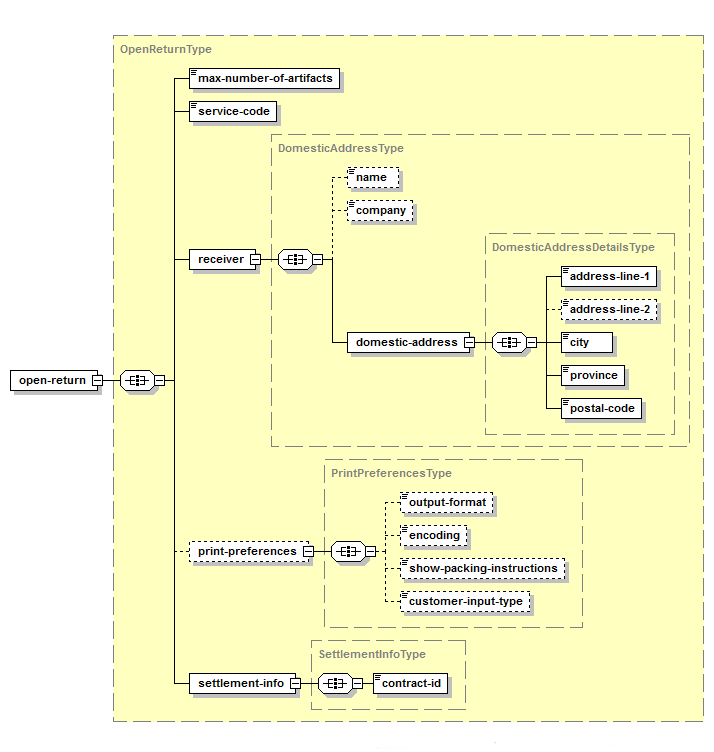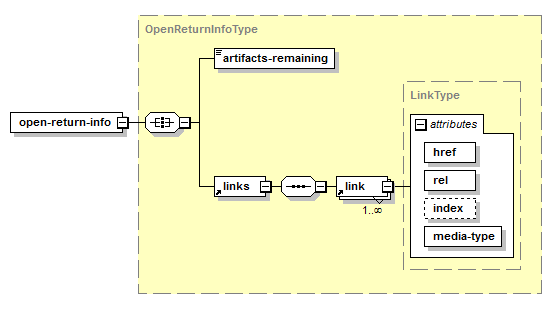Returns
Create Open Return Template – REST
Summary
| Name: | Create Open Return Template |
|---|---|
| Reason to Call: | Used to create a number of generic return shipping labels (up to 100,000) where the sender address and weight are unknown. |
| Input: | Shipping input information |
| Output: | Links to the created template as well as a link to the service to retrieve the return labels. |
| Error Example: | Errors in address or parcel characteristics. |
| Typical Next Call: | Retrieve Next Open Return Artifact. |
| Version history: | Release notes |

Create Open Return Template
Request Details
Request – Structure for Create Open Return Template
Endpoint
POST https://XX/rs/{mailed by customer}/{mobo}/openreturn |
|
|---|---|
| Replace... | With... |
XX (Development) |
ct.soa-gw.canadapost.ca |
XX (Production) |
soa-gw.canadapost.ca |
{mailed by customer} |
your customer number |
{mobo} |
the mailed on behalf of customer number or repeat your customer number |
HTTP Headers
HTTP Header Variable |
Value |
|---|---|
Accept |
application/vnd.cpc.openreturn-v2+xml (Note: */* in place of the header value will return an error) |
Content-Type |
application/vnd.cpc.openreturn-v2+xml (Note: */* in place of the header value will return an error) |
Authorization |
Basic {Base64 encoding of userid:password} |
Accept-language |
en-CA or fr-CA |
Body
<?xml version="1.0" encoding="utf-8"?>
<open-return xmlns=”http://www.canadapost.ca/ws/openreturn-v2”>
xxx
</open-return>
Request – Elements
This table describes the XML elements that make up the input to this service. The hierarchical structure of the XML inputs is shown in the Request - XML Diagram.
| Create Open Return Template – Request Elements | |||||||||||||||||||||||
|---|---|---|---|---|---|---|---|---|---|---|---|---|---|---|---|---|---|---|---|---|---|---|---|
| Element Name | Type | Required / Optional | Description | ||||||||||||||||||||
open-return |
Complex |
Required |
This is the overall XML structure for the request input information. |
||||||||||||||||||||
max-number-of-artifacts |
Simple |
Required |
Indicates the maximum number of artifacts (return labels) you can generate and retrieve using this template. Must be numeric in the range of 1 - 100,000. |
||||||||||||||||||||
service-code |
Simple |
Required |
(32 alphanumeric) The returns service is appropriate for domestic returns only.
|
||||||||||||||||||||
receiver |
Complex |
Required |
This structure contains data about the destination that will appear in the “To” address of the label. Blank fields will be removed during address formatting. |
||||||||||||||||||||
name |
Simple |
Required |
(44 characters) |
||||||||||||||||||||
company |
Simple |
Optional |
(44 characters) |
||||||||||||||||||||
domestic-address |
Complex |
Required |
This structure contains address data about the receiver of the shipment. |
||||||||||||||||||||
address-line-1 |
Simple |
Required |
(44 characters) |
||||||||||||||||||||
address-line-2 |
Simple |
Optional |
(44 characters) |
||||||||||||||||||||
city |
Simple |
Required |
(40 characters) |
||||||||||||||||||||
province |
Simple |
Required |
(2 characters) |
||||||||||||||||||||
postal-code |
Simple |
Required |
(6-digit code in Canadian Postal Code pattern: A9A9A9) |
||||||||||||||||||||
print-preferences |
Complex |
Optional |
This structure contains print preferences for the labels. |
||||||||||||||||||||
output-format |
Simple |
Optional |
(7 alphanumeric) Note: The 3x5 format was discontinued in June 2016, but for an interim period will still be accepted and converted to 4x6. |
||||||||||||||||||||
encoding |
Simple |
Optional |
{PDF, ZPL} Use this field to specify the output format for your return label: PDF or ZPL II. If not provided, PDF will be selected by default. If you choose ZPL, the response from a Get Artifact call will include a file containing ZPL II printer commands. You will then need to either code a solution or use an application to stream the commands directly to a thermal printer. For ZPL II labels, your printer must support truncation. Use our sample code to test your printer’s ability to truncate text. ZPL is only available on thermal paper. The <output-format> must therefore be 4x6. |
||||||||||||||||||||
show-packing-instructions |
Simple |
Optional |
{true, false} |
||||||||||||||||||||
customer-input-type |
Simple |
Optional |
(20 alphanumeric) Use this element to create return labels that contain a spot for your customers to enter data such as a part number, SKU number, etc. This field only applies to 4x6 and 8.5x11 label sizes. Valid values are as follows:
|
||||||||||||||||||||
settlement-info |
Complex |
Required |
This structure contains your regular outgoing parcel contract number for verification purposes. |
||||||||||||||||||||
contract-id |
Simple |
Required |
(10-digit numeric) |
||||||||||||||||||||
Request – XML Diagram
The following is the hierarchical structure of the XML for the request to Create Open Return Template.
Create Open Return Template – Structure of the XML Request

Response Details
The following table describes the XML fields in the response. For a detailed view of the hierarchy of the response, see the XML diagram.
| Create Open Return Template – Response Elements | ||
|---|---|---|
| Element Name | Type | Description |
open-return |
Complex |
This is the top level XML element for the response. |
artifacts-remaining |
Simple |
This is a numeric value indicating the number of artifacts remaining that can be drawn down. It is initially set to the number-of-labels in the request. |
links |
Complex |
This structure represents a list of links to information relating to the open-return template that was created. |
link |
Complex |
There are three link elements contained within the links structure, one with rel=”self”, one with rel=”details” and one with rel=”nextArtifact”. Examples<link <link <link Each link has three attributes as follows.
|
Response – XML Diagram
The following diagram shows the XML structure of the response from the Create Open Return Template service.
Create Open Return Template – Structure of the XML Response

Response – Possible Error Responses
In the case of an application error, an HTTP 400 level status code error response will be generated and the XML body will have an error message structure rather than the success response. For more information, see HTTP status codes.
Possible error messages for this service include the following:
| HTTP Status Code | Application Error | Message |
|---|---|---|
| 500 | N/A | Detailed schema validation error is provided. |
| 412 | 9999 |
Examples
Sample REST XML Request – Create Open Return Template
<open-return>
<max-number-of-artifacts>10</max-number-of-artifacts>
<service-code>DOM.EP</service-code>
<receiver>
<domestic-address>
<address-line-1>2701 Riverside Drive</address-line-1>
<city>Ottawa</city>
<province>ON</province>
<postal-code>K1A0B1</postal-code>
</domestic-address>
</receiver>
<print-preferences>
<output-format>8.5x11</output-format>
</print-preferences>
<settlement-info>
<contract-id>12345678</contract-id>
</settlement-info>
</open-return>
Sample REST XML Response – Create Open Return Template
<open-return-info>
<artifacts-remaining>10</artifacts-remaining>
<links>
<linkrel="self"href="https://ct.soa-gw.canadapost.ca/rs/0007023211/0007023211/openreturn/349641323786705649"media-type="application/vnd.cpc.openreturn-v2+xml"></link>
<linkrel="details"href="https://ct.soa-gw.canadapost.ca/rs/0007023211/0007023211/openreturn/349641323786705649/details"media-type="application/vnd.cpc.openreturn-v2+xml"></link>
<linkrel="nextArtifact"href="https://ct.soa-gw.canadapost.ca/rs/0007023211/0007023211/openreturn/349641323786705649/artifact"media-type="application/pdf"></link>
</links>
</open-return-info>
